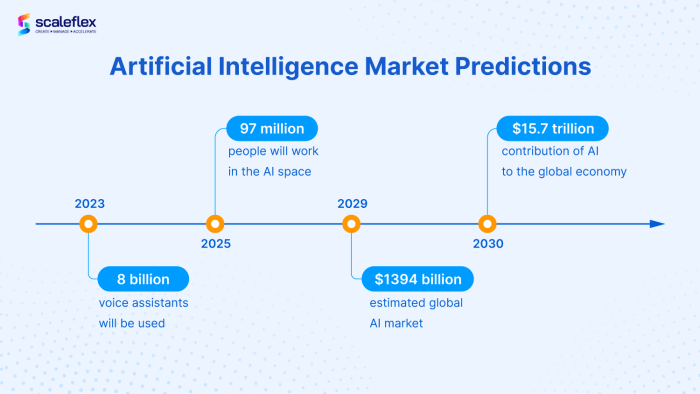
Diving into the realm of AI market projections, we embark on a journey to explore the crucial role these forecasts play in shaping the business landscape. Prepare to be captivated by the intricate dance of technology and economics as we unravel the mysteries behind AI market projections.
As we delve deeper, we will uncover the significance of AI market projections for businesses, investors, and industries, shedding light on their pivotal role in strategic decision-making and market positioning.
Overview of AI Market Projections
AI market projections refer to forecasts and estimates regarding the growth and trends of the artificial intelligence market. These projections are based on data analysis, historical trends, and market research to predict the future state of the AI industry.
Businesses and investors rely on AI market projections to make informed decisions about investments, product development, and strategic planning. These projections provide valuable insights into the potential growth opportunities, market demand, and competitive landscape within the AI sector.
Importance of AI Market Projections
- AI market projections help businesses identify emerging trends and opportunities within the industry, allowing them to stay competitive and adapt their strategies accordingly.
- Investors use AI market projections to assess the potential return on investment and make informed decisions about funding AI-related projects or companies.
- By analyzing AI market projections, businesses can anticipate changes in consumer behavior, technological advancements, and regulatory developments that may impact their operations.
Industries Relying on AI Market Projections
- Healthcare: AI market projections are crucial for healthcare organizations looking to implement AI-driven solutions for patient care, disease diagnosis, and medical research.
- Finance: Financial institutions use AI market projections to optimize trading strategies, detect fraudulent activities, and enhance customer experience through personalized services.
- Retail: Retailers leverage AI market projections to forecast consumer demand, optimize pricing strategies, and enhance the shopping experience through personalized recommendations.
Factors Influencing AI Market Projections

When it comes to projecting the growth of the AI market, several key factors play a significant role in shaping these projections.
Technological Advancements
Technological advancements are a crucial driver in influencing AI market projections. As new innovations and breakthroughs continue to emerge, the capabilities and applications of AI technology expand, leading to increased investments and market growth.
Economic Trends
Economic trends also have a substantial impact on AI market projections. Factors such as GDP growth, government policies, and industry-specific trends can either spur or hinder the adoption of AI technologies, thereby influencing market forecasts.
Global AI Market Size and Growth Trends
When looking at the current size of the global AI market based on recent projections, it is evident that the industry is experiencing rapid growth and expansion. The market size is constantly evolving as new technologies are developed and implemented across various sectors.
Current Global AI Market Size
According to recent reports, the global AI market size is estimated to be around $62 billion in 2021
Expected Growth Trends
- The AI market is expected to continue its upward trajectory in the coming years, with projections indicating a compound annual growth rate (CAGR) of over 40%.
- Factors such as increasing adoption of AI in industries like healthcare, finance, and retail are driving this growth, as organizations seek to leverage AI for improved efficiency and decision-making.
- Emerging technologies like machine learning, natural language processing, and computer vision are also contributing to the expansion of the AI market, opening up new opportunities for innovation and development.
Comparison of Reports
It is important to note that different reports may vary in their projections of the global AI market size and growth trends. While some sources may be more conservative in their estimates, others might be more optimistic based on various factors and assumptions.
Regional Analysis of AI Market Projections
When analyzing AI market projections, it is crucial to consider the differences in various regions such as North America, Europe, Asia Pacific, and others. These regions have unique economic factors and regulatory policies that directly impact the growth and adoption of AI technologies.
North America
- North America is a frontrunner in AI technology adoption, with major tech hubs in Silicon Valley and Seattle driving innovation.
- The region benefits from a strong economy, robust investment in research and development, and a supportive regulatory environment that encourages AI development.
- Key players like Google, Amazon, and Microsoft have their headquarters in North America, contributing to the region's dominance in AI technology.
Europe
- Europe has been actively investing in AI research and development, with countries like the UK, Germany, and France leading the way.
- The region faces challenges with data privacy regulations like GDPR, which impact the collection and use of data for AI applications.
- Despite these challenges, Europe is making significant strides in AI adoption, particularly in industries like healthcare, finance, and manufacturing.
Asia Pacific
- Asia Pacific is a rapidly growing market for AI technology, with countries like China, Japan, and South Korea investing heavily in AI research and development.
- The region benefits from a large pool of tech talent, government support for AI initiatives, and a growing demand for AI solutions across various industries.
- China, in particular, has emerged as a global leader in AI, with companies like Alibaba, Tencent, and Baidu driving innovation and growth in the market.
Other Regions
- Other regions around the world are also witnessing increasing adoption of AI technologies, albeit at a slower pace compared to North America, Europe, and Asia Pacific.
- Factors like limited access to resources, infrastructure challenges, and regulatory hurdles can hinder the growth of the AI market in these regions.
- However, initiatives are being taken to bridge the gap and promote AI innovation in these emerging markets.
Wrap-Up
In conclusion, the world of AI market projections is a dynamic and ever-evolving landscape that holds immense potential for growth and innovation. By understanding the factors influencing these projections, businesses can navigate the complexities of the market with confidence and foresight.
Commonly Asked Questions
How accurate are AI market projections?
AI market projections are based on extensive data analysis and trends; however, they are subject to change due to various factors. It's essential to regularly update projections to reflect the evolving market dynamics.
Can AI market projections be used for long-term strategic planning?
Absolutely. AI market projections provide valuable insights for long-term strategic planning by identifying trends, opportunities, and potential risks that businesses can leverage or mitigate in their planning processes.
Do AI market projections consider geopolitical factors?
Yes, AI market projections take into account geopolitical factors as they can significantly impact market trends and dynamics, influencing the accuracy of projections in different regions.












